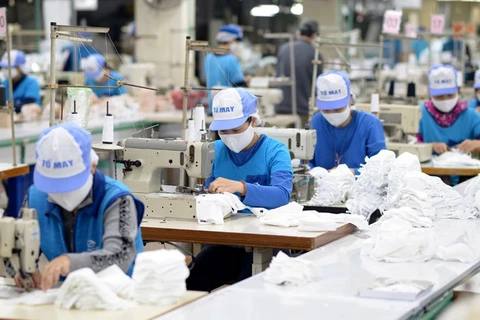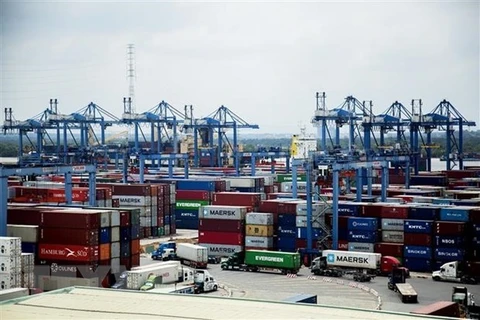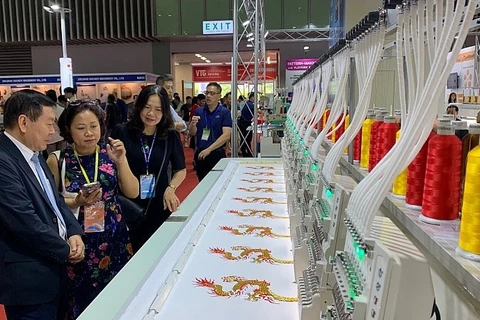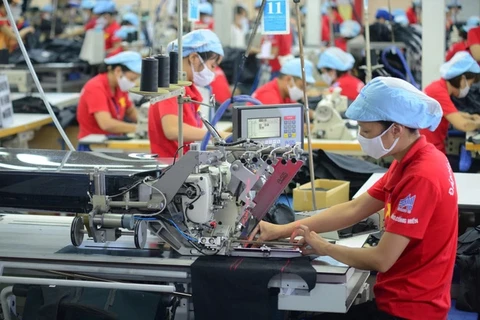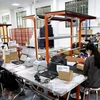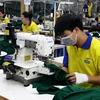 Textile and garment businesses have applied advanced technology to increase labour productivitiy. (Photo: VietnamPlus)
Textile and garment businesses have applied advanced technology to increase labour productivitiy. (Photo: VietnamPlus) Hanoi (VNA) – While there haven’t been any signs of recovery in the number of orders for the year-end months, many members of the Vietnam National Textile and Garment Group (Vinatex) now must seek orders for each month and are also facing low processing prices and strong competition from other countries.
Given this, Vinatex General Director Cao Huu Hieu said the focal task for the remaining months of 2023 is to maximise all market opportunities. This includes optimising production to increase productivity, fulfilling even small orders that have high quality requirements, building flexible production plans, and arranging personnel to optimise labour cost.
Actively dealing to difficulties
- How has the panorama of member businesses of Vinatex been over the past months?
Mr. Cao Huu Hieu: Looking back on the market situation since the beginning of the year, the export of Vietnamese textile and garment products has faced numerous difficulties as economic and political uncertainties have led to inflation. This hampers consumption indexes in large export markets of the country. As textiles and garments are not essential goods, the decline in their consumption has been very sharp.
As of September 2023, Vietnam’s textile and garment exports had reached 29.7 billion USD, down 14% from the same period of 2022. At present, the US remains the biggest market, accounting for an over 40% market share of Vietnam’s textile and garment sector, followed by Japan, the EU, the Republic of Korea, and China.
Vietnam has recorded decreases in exports to the abovementioned markets due to falling demand. The EU market is an example. During the first seven months of 2023, Vietnam’s textile and garment exports to this market posted only 2.3 billion USD, down 9.6% year on year. In August, shipments dropped more strongly to only 330 million USD, down 17% year on year, and continued the downward trend in September because orders from such major partners as Decathlon, Nike, and Adidas nosedived.
To the US market, in the first half of 2023, Vietnam’s textile and garment sector lost 1.3% of its market there. The exports from Vietnam to China during the first eight months also reached only 7.5 billion USD, down 11.6% from the same period last year.
In the “grey” market panorama during the first nine months of this year, the only silver lining was the fast growth in exports to member countries of the Comprehensive and Progressive Agreement for Trans-Pacific Partnership (CPTPP) like Japan, Canada, Australia, and New Zealand. Besides, we have managed to open some new markets in Africa and the Middle East. This has helped the sector’s export revenue hold amid plummeting demand in other markets.
- Could you provide more details about the situation of orders placed on businesses in the recent past? Which is the biggest difficulty they are facing?
Mr. Cao Huu Hieu: At recent meetings between the Board of Directors, the governing body of Vinatex, and its units to discuss the production and business situation during the remaining months of 2023, they generally perceived that there haven’t been many bright spots in terms of markets and customers.
Accordingly, there haven’t been any signs of recovery in the number of orders. Most members lack orders for the last three months, and some even have to seek orders for each month. Processing prices are still about 30% lower than in the past. The price competition with other textile and garment exporting countries like Pakistan, Indonesia, and especially Bangladesh is increasingly fierce. In addition, requirements from buyers are becoming stricter. Small and difficult orders with high quality requirements are still the trend for the short term.
However, the common point of the working sessions and discussions is the positive attitude and the certain maturity of the units amid difficulties of 2023. This is seen in their capacity assessment, operation improvement, and production governance. Changes in production governance have generated higher effectiveness, a more flexible personnel structure, and the staff’s better proactiveness and problem-solving capacity.
Some units have also spotted more positive signs from the market in the fourth quarter. To the garment sector, customers have increased looking for information though they haven’t officially placed orders. Garment companies are stepping up producing samples and informing customers of prices, with the price structure “optimised”, with the hope of receiving orders for the coming period.
To the yarn sector, signs indicate that the situation has bottomed out. Some markets have shown recovery signs though demand is still low. In August, several firms almost broke even, and some recorded profit. However, these signs are relatively fragile as the garment sector still lacks orders for the year-end months and the yarn sector is seeing a slight increase in cotton prices while yarn prices have yet to see positive signs.
August was also the first month since the beginning of the year when Vietnam’s textile and garment exports hit 4 billion USD. There haven’t been any predictions saying such costs as oil prices, power prices, interest rates, and logistics expenses will increase. Given this, it could be optimistic that the market situation in the fourth quarter will not improve but stabilise compared to the first six months of 2023.
- It is true that Vietnam’s textile and garment export is struggling with strong competition from many countries. Facing such difficulties, what are the group’s orientations to improve production and business effectiveness and maintain Vietnam’s market share in the world?
Mr. Cao Huu Hieu: After prolonged difficulty, which was also a period of filtering and examining the “health” of businesses, apart from the units completely swept away by the market “whirlwind”, some have still sustained relatively high production effectiveness. Experiences from these units show that the factors helping them gain the competitive edge and organise efficient production include good and consistent product quality. In the period of order scarcity, those who maintain high quality are likely to be the first to receive orders.
Moreover, other factors include a good production management system that enables businesses to have strict and flexible control, fulfill small orders and ensure quick delivery. Others include the optimisation of personnel to increase labour productivity, good customer care services and policies, and compliance with the regulations on social responsibility and environment. It is also important that businesses show their capability of controlling supply chains and tracing product origins to prove they do not violate the labour rules of import markets, and directions for investment in green and circular production.
Therefore, Vinatex leaders have asked member units to pay attention to the abovementioned factors. They could prove critical conditions to survive in the time ahead, when it is predicted that difficulties may not be over in the first half of 2024.
In addition, the group’s governing body will also boost activities to help its affiliates complete their production and business plans. Besides, the monitoring, management, and connection of members will continue to be improved via various forms, especially enhancing the connecting and governing role of the board for yarn and garment production and marketing.
The group will build flexible steering and governing mechanisms and prioritise the “hot spots” that require immediate settlement to avoid production disruptions or lay-offs. The also plan to strictly control the financial situation of key units and give timely and continuous directions and assistance to members.
- During the COVID-19 pandemic, textle and garment businesses could be said to have properly navigated difficulties. Which directions has Vinatex issued for the time ahead to continue affirming its stature in terms of production and export?
Mr. Cao Huu Hieu: The focal tasks for the remaining months of 2023 are to maximise all market opportunities, optimise production to increase labour productivity, fulfill small orders that have high quality requirements, build flexible production plans, and appropriately arrange personnel to optimise labour cost.
One of the important things is to take swift and strong actions based on the thorough consideration of continually and opportunely provided input information. Actions, not thoughts, is decisive. The entire group is determined to complete the issued plans in the best possible manner and stay steadfast in the face of adverse factors in the market. This is also an important prerequisite for building the group’s production and business plan for 2024 in a proactive and reasonable fashion.
Businesses are unable to select market contexts, but completely able to decide the attitude and methods they hold to overcome the year 2023 and enter 2024. With the proactiveness and confidence based on effectively controlled information, Vinatex is completely confident to welcome development recovery with a new attitude, new capacity, and new efficiency.
- Thank you very much./.



